ALLIGATOR BEHAVIOR page 5a: BABY ALLIGATORS--page
1 2
3
4
5
6
7
8
9
10
11
12
This page was born 9/08/2002. Rickubis designed
it. (such as it is.) Last update: 10/05/2022
Images and contents on this
page copyright ©2002-2022 Richard M. Dashnau
Here is another surprising aspect of alligator
behavior. They will protect their eggs through incubation (about
60 days), and then will protect their hatchlings for
around two years. I've witnessed the care that a female
alligator shows while she moves among a newly-hatched pod of
baby alligators. I've faced a female alligator over her young,
and stood and watched her with respect on more than one
occasion. If her babies gave an alarm, she--with her eyes upon
me--would quietly move closer to me, in the water. Only
if I didn't give way, or if others moved quickly or loudly,
would she actually begin her threatening behavior. If one gives
her respect, then she remains quiet, though watchful. The
picture of a silent, strong protector of its young is not the
mental image most people would have of an alligator. Maybe these
pages can alter the common perception of alligators.
Additional August 27 follows!
If you were able to watch and
hear the video clip with sound, then you heard 3 sounds, sort of
like a cross between a chirp and a croak. Juvenile alligators make
these sounds. The following information
is drawn from:
Crocodilian Biology and
Evolution, Gordon C. Grigg, ed. Feb, 2001. The information is in
Chapter 30, written by Adam R. C. Britton. (italics are my own conclusions/thoughts)
This chapter deals with
crocodilians in general, but seems to indicate that the different
species share similar behaviors. In any case, it's
interesting. From before they are born, young crocodilians
vocalize.
They begin chirping while still inside the egg. This is thought to
alert nearby adults (usually the
mother, since she is normally guarding the nest) to approach the nest. Apparently, even
male animals will
respond with assistance (That is,
they don't come to eat the young.)
An interesting point is that other animals, notably
predators, could also be alerted by these sounds, and could also
respond. If they
reach the before the adult crocodilian, then the young wouldn't
survive. Then, after they are born, the young alligators
will continue to make various sounds. What is most interesting is
that there are different
sounds for different
situations, or to give different messages. The chapter lists 5
different calls (possibly 6). This is only one study. As with all
scientific work, it is subject to further experimentation
and
verification. Calls in the study were analyzed with sonograms, and
broken down into components. So, many differences between the calls are quite
subtle, and difficult, if not impossible to detect by
humans. Some
of
these signals can probably be read by context. The 5 main
types were: Hatching, Contact, Threat, Annoyance, and Distress.
1. Hatching Calls--these were divided
into "pre-hatching", and "post-hatching" calls. The study gives
differences between
calls as occurring from
milliseconds of duration, frequency, and harmonic. The
"pre-hatching" call is thought to cause the adult to open the
nest, while the "post hatching" call may help the adult locate the
newborn to carry it to the water. There is also mention of another
possible sound that may prevent the adult from swallowing the
young while it's being carried in the adult's mouth. However, some of these
difference could be due to physical conditions around the baby,
such as the egg muffling the sound (I suppose being inside an adult's mouth might
cause produced sounds to be seem different also.)
For those who wonder, the chapter *does* mention that how the
babies can produce sounds *inside* the egg isn't known.
2. Contact Calls-- are
given from time to time, and are probably used so the young
animals can recognize their group. That is, this call helps keep
the pod together. Sometimes one baby approaching
another will make one of these sounds. Sometimes it gets an
answer. These are probably the sounds that are being made on my
video clip. These happen in non-threatening situations.
Young
crocodilians (hereafter,
just
"crocs") apparently
respond
to this sound favorably, sometimes responding to similar sounds made by other
non-threatening animals, or even the adult female.
3. Threat calls--With
the social behavior of depending on adult animals for protection,
young crocs normally will seek to escape, hide, and call for an
adult if threatened (Who wouldn't want a dragon 10
times their size that they could call on for help? A baby alligator is 9
inches long. A large female is 9 feet, or 108 inches long.) . On rare
occasions, however, they will attempt to face down their
tormentor. When doing so, they will show aggressive body
postures while
making the noise. These sounds seem to be quite different from the
other vocalizations. (From
what I can see, these are more
related to loud "hissing" noises the the "croaking" noises.)
4. Annoyance
calls--These are high-pitched sounds that a young croc might make
after it has been grabbed. These are used in conjunction with
attempts to bite their attacker. There is no evidence
either way that shows an adult would respond to these calls. These
are generally a higher pitch than "distress calls".
5. Distress
calls--These occur when a young croc feels threatened. They seem
to be primarily for summoning an adult. Adults other than the
actual parent may respond. These calls can also serve as a
warning to other juveniles in the area
(probably
in the same pod) that
there is trouble. One drawback of this behavior is that the
caller could be eaten before help could arrive.
Another concept I hadn't considered was an
alligator's voice changing as it grows
(similar to the way ours does). As they grow, and
some species can grow to more than 10 times their birth size,
the
structures that make the sounds also grow. Generally, the "peak
frequency" of their calls lowers. That is, their voices get
deeper. There is mention that adults respond more rapidly to
higher-pitched distress
calls, than to lower ones. I
surmise that after a certain point, the adult no longer
recognizes or responds to a distress call that falls outside a
certain frequency window. Although they still may make
distress calls, the adult will not respond. I also believe that
with this comes another behavior, where the young alligator has
become large enough to be recognized as a threat to the current
brood, and
may be chased off. I see
many alligators around 3 feet long by themselves at the
park. I see few between 2 and 3 feet long alone. If
this interests you at all, I urge you to locate the book, and
either buy it
or borrow it. The book is a collection of different papers by
different study groups. Much of it is quite technical, but it's
still interesting.
August 25, 2002Most
important news: BABY ALLIGATORS at the park! Readers may
recall that a few weeks ago (see heading August 18 above) the park
naturalists had to relocate 28 eggs from an alligator
nest that had flooded. On Wednesday, August 21, the eggs hatched!
Actually, 19 of the 28 eggs hatched. The remaining 9 eggs turned
out to have been infertile. Not bad! Not bad at all! I wish I
could have been
there, but alas, I was at work, and the eggs began hatching around
3:00 pm. However, today (Sunday) I was able to visit the new
additions to the park. The image below (SOME HANDFUL) shows my
hand
holding some of these new alligators. The young gators were
surprisingly docile, and did not show much alarm at my approach.
Of course I only handled these animals with permission from the
park naturalists.
More images of these 4-day-old babies follow.
They are about 9 inches long
(YOUNG SIZE, below). We have 3 live alligators in the Visitor's
Center that were born almost a year ago. Here are two
pictures
comparing the two. Note that the young in the VC are not fed as
often as they'd like to be, but they *do* eat all year.
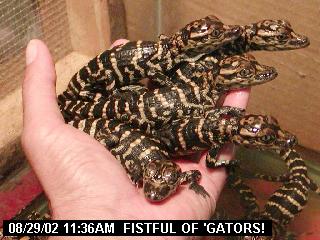
SOME HANDFUL
YOUNG
SIZE
COUSIN?
BIG DEAL, ONE YEAR
Therefore the wild
alligators may be a bit larger than this one. (see COUSIN?, and
BIG DEAL, ONE YEAR, above). Even after 4 days, the yolk sack they
are born with is still visible (see YOLK SACK, below)
Like many other reptiles,
alligators are born with a "Developmental Chamber Escape Tool" (my
term), otherwise known as an "egg tooth". This is a
temporary sharp "tooth" that is usually at the tip of the
skull
(near the nostrils), that is used to tear through the egg
membrane, and sometimes the softer shells of reptile eggs.
Sometime later, this "tooth" falls off. Here is a young
alligator's face (see BABY PICTURE,
below) and a close-up of the egg tooth (EGG TOOTH, below). The egg
tooth is the white triangular spot on the tip of the snout. The
entire young alligator, as it lies quietly in my hand (IN MY HAND,
below).
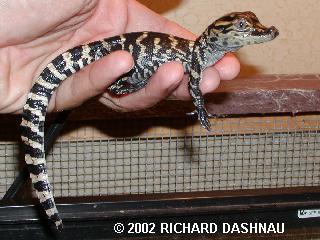
YOLK
SACK
BABY
PICTURE
EGG
TOOTH
------IN
MY HAND
Also, David (park
naturalist) attempted to give these young alligators their first
meal. Remember, there are born with a yolk sack, and this sustains
them for their first few days of life. Two of the young
alligators
did take the food (large chunks of diced earthworm...LE YUM!),
while most of them ignored it; although a few did bite on the
worms, chew them and spit them out. I was able to get a few
film clips of this first
successful feeding.
Here are three links (the
pictures below are from the clips):
4-day-olds,
with
a few chirps. (flv video 433kb, see BROTHERS AND SISTERS ,
below)
4-day-old's
first
attack (real video 503kb, see AM I SUPPOSED TO EAT THIS?,
below).
4-day-old's
first
prey (flv video 478kb, see MMMMM...BOY!, below).
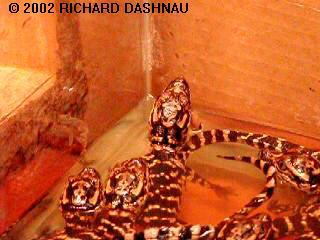
BROTHERS
AND SISTERS
AM I SUPPOSED TO EAT
THIS?
MMMMM...BOY!
This was a pretty
successful hatching. Usually, the mother alligator would have
assisted with this hatching. That means that when the babies
started croaking, the mother would have gently scraped the top off
the nest and helped the babies leave their eggs. The mother gators
have been observed gently cracking the shells in their jaws, and
carrying the live babies to the water. Even after the
hatching the mother will
protect her young, for two years or so. In spite of all this
protection, one alligator in 60 (yes--ONE IN SIXTY) will survive
the first 3 years of life. This high mortality rate is due mostly
to predation by numerous
animals which view young alligators as a food item. These can
include snakes, turtles, wading birds, fish (remember the giant
alligator gar we found at the park?), raccoons, river otters
(these have been
observed at Brazos Bend State Park), and other alligators. A
particularly severe winter can also cause smaller alligators to
die. Therefore, I considered myself very lucky to be able to
observe such a group
of newborn alligators so closely.
June 30, 2002
It had been raining all weekend. Not steadily, but enough to
make things wet and the air close and sticky. I hadn't been
at the park very long, before it started raining on me. I was near
the
water station on Elm Lake Trail, and between that point and to
about 75 yards past the first pier, I saw 8 alligators lying still
in the water. For at least 15 minutes, all the alligators were
unmoving, and facing
the trail (SEE RAINY MORNING, below) . Two smaller
alligators were very close to the shore, and one of them is the
rickubiscam shot for this week. After this brief period of
stillness, during which the rain
paused for a short time, the the some of the alligators began
moving around. There were two larger alligators (probably males),
near in the group. Two of the mid size alligators (about 6 feet
long) started
moving first. The alligators slightly tilted their heads as they
swam, showing the their lips above the surface, but keeping the
head almost horizontal. They also showed most of their upper back
and tail as
they swam at a leisurely pace. Eventually, all the alligators had
scattered. The
rain finally stopped, at around 10:00. I wandered the trails
for a while, which were clear of visitors.
Sometime later, I, and a
couple others, went to visit one of our new alligator nests.
Alligators build nests during this month, and two have nested
within easy sight of one of our most accessible trails, the
Creekfield
Trail. The first nest is about 10 minute's walk from the Visitor's
Center, and close enough to be seen easily from the trail, yet far
enough away from the trail for the mother to be undisturbed (and
therefore not
moved to vigorously defend her nest). Although we are far
enough away from her nest, the female is definitely keeping an eye
on us. See SHE'S WATCHING ME, below. She is actually
behind the nest (from
the viewpoint of the trail). The nest is the pile of old grass and
logs in front of her. This female has put some pretty large
pieces of wood into her nest. If her nest remains unharmed
(unfortunately, there are many
raccoons in the area she chose), she will guard her nest for
the 60 days required to incubate her eggs. This is one of the
largest females-if not the largest-that I've seen at the
park. It's not possible to be 100
percent sure of an alligator's sex unless one does a physical
examination, but nest-guarding behavior is not shown by male
American Alligators.
----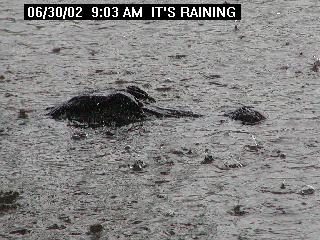 ----
----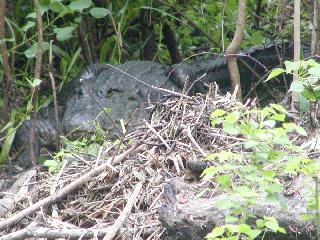 ----
----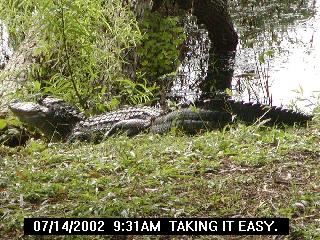
RAINY
MORNING
SHE'S WATCHING
ME
MY VISITOR
August 18, 2002Most
important news: WE GOT RAIN at the park! About 9 inches worth, and
now the park looks like it should. Unfortunately, the two
alligator nests by the Creekfield trail were threatened by the
raised water level. In fact, one nest was totally submerged, so
the eggs were relocated. The other nest was left alone,
since the top of it was still above water. The nest looked
like this before the rain (see DRY
NEST, below.) And now, it looks like this (see WET NEST, below.)
DRY NEST
WET
NEST
September 23, 2001.
Have I mentioned that I think alligators are pretty cool? Of course
I have! Maybe I haven't made this clear. Actually, I'm not doing
this to make anyone believe they are interesting. I do this
because I already think that they are. Alligators are not
typical reptiles. They are among the largest living reptiles.
They have a 4 chambered heart (other reptiles have 3 chambers), and
they protect their
young for up to two years. This time, I was fortunate enough to
encounter a litter of baby alligators (BABIES!,
below), along with their mother...or at
any rate, an adult alligator who was very protective. I'd
already
heard of her...interactions with some of the park staff. The water
level was still high at the park, so the water came up very close to
the paths. When someone approached too close to her brood, the
mother
would hiss, and/or slap the water with her tail or jaw (by slapping
with her head). At this point, the prudent person leaves the
area. At Brazos Bend Park, the alligators have the
right of way at all times.
I approached to about 15 feet, and then let the video camera do the
work of zooming in closer. The mother alligator kept a close
eye on me, anyway. Here
is a video clip of the alligators and their protector
. (flv video 747kb)
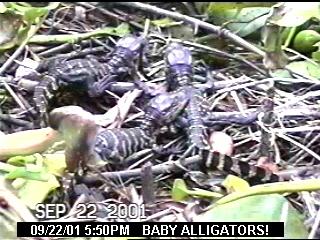
BABIES!
And,
this page shows alligators at the park, on
land, near various landmarks at the park.
Go back to my
main alligator page, Alligators
Go back to my home page, Welcome
to rickubis.com
Go
back
to the RICKUBISCAM
page.
Go back to the See
the
World page.






